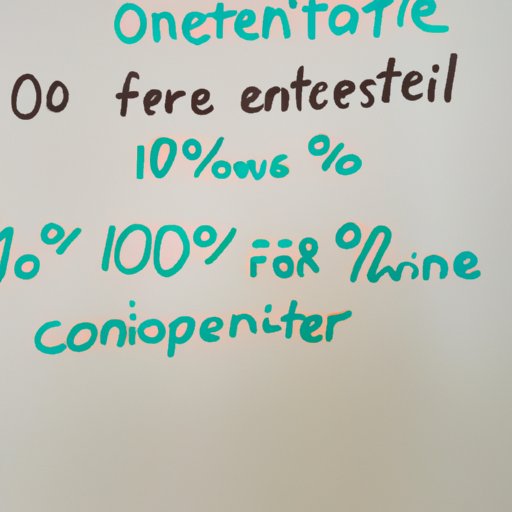
Introduction
Figuring out percentages can be tricky, but it’s an essential skill that everyone should have. Whether you’re calculating a discount, determining a tip, or considering a pay raise, percentages are everywhere in our daily lives. This article aims to provide beginners with a step-by-step guide to figure out percentages and apply them to real-world situations.
Step-by-Step Guide
A percentage is a way of expressing a quantity as a fraction of a hundred. It’s important because it helps us to compare numbers and understand the relationship between them. To calculate a percentage, follow these steps:
- Step 1: Convert the percentage to a decimal by dividing it by 100.
- Step 2: Multiply the decimal by the number you want to find the percentage of.
- Step 3: That’s it! You’ve found the percentage!
For example, if you want to find 25% of 80, you would:
- Divide 25 by 100, which is 0.25.
- Multiply 0.25 by 80, which is 20.
- Therefore, 25% of 80 is 20.
Remember, you can also use this formula to find the original amount if you know the percentage and the result. Just divide the result by the percentage as a decimal to get the original amount.
Here’s an example:
- If you have 20% off a $50 shirt, what is the sale price?
- Convert 20% to 0.20 by dividing by 100.
- Multiply 0.20 by $50 to get $10 off the original price.
- Subtract $10 from $50 to get the sale price of $40.
- Therefore, the sale price of the shirt is $40.
These steps may seem complicated at first, but with practice, you’ll be able to calculate percentages quickly and easily!
Real-World Scenarios
Percentages are commonly used in everyday situations. Here are a few examples:
- Calculating a tip at a restaurant
- Determining the sales tax on a purchase
- Figuring out the discounted price of a sale item
Some of these situations may require more complex percentage formulas, but the basic calculation steps will always come in handy. It’s also helpful to practice mentally calculating percentages to estimate tips or sale prices when you don’t have a calculator. For example, if you need to leave a 20% tip on a $30 meal, you could quickly estimate that it’s around $6 (10% is $3, so doubling that gives you 20%).
Visual Aids
Visual aids can be extremely helpful when learning about percentages. Here are some useful aids:
- Line graphs
- Pie charts
- Bar graphs
Using these aids can make understanding percentages much easier. For example, a pie chart can show you what percentage of a budget is spent on different categories.
Multiple Scenarios
Percentages are used in many different contexts, from business and finance to science and statistics. Here are some examples:
- Calculating interest on a loan
- Determining profit in a business
- Estimating population growth
Practicing with different scenarios can help you get comfortable with percentages in different situations and understand how they are used in the real world.
Explaining Math Principles
The math principles behind percentages can be a bit confusing. Here are some basic formulas and concepts that will help:
- Percentage = (Part/Whole) x 100
- Decimal = Percentage/100
- Fraction = Percentage/100
Remembering these formulas and applying them correctly will make calculating percentages much easier. It’s also helpful to break down a percentage into simpler fractions or decimals to make the calculation simpler.
Conclusion
Figuring out percentages may seem challenging at first, but with practice and patience, it’s a skill that anyone can learn. By following this step-by-step guide, practicing with real-world scenarios, and using visual aids to understand percentages, you’ll be calculating percentages like a pro in no time! Remember to reinforce your understanding by practicing on your own, and don’t be afraid to seek additional resources if you need help.




